- Clone
- DREG-56 (See other available formats)
- Regulatory Status
- RUO
- Workshop
- V S056
- Other Names
- L-selectin, LECAM-1, LAM-1, Leu-8, TQ-1
- Isotype
- Mouse IgG1, κ
- Ave. Rating
- Submit a Review
- Product Citations
- publications
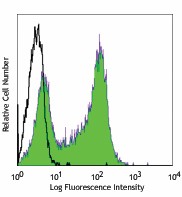
-

Human peripheral blood lymphocytes stained with DREG-56 Pacific Blue™
| Cat # | Size | Price | Quantity Check Availability | Save | ||
|---|---|---|---|---|---|---|
| 304825 | 25 µg | 100€ | ||||
| 304826 | 100 µg | 212€ | ||||
CD62L is a 74-95 kD single chain type I glycoprotein referred to as L-selectin or LECAM-1. It is expressed on most peripheral blood B cells, subsets of T and NK cells, monocytes, granulocytes, and certain hematopoietic malignant cells. CD62L binds to carbohydrates present on certain glycoforms of CD34, glycam-1, and MAdCAM-1 and with a low affinity to anionic oligosaccharide sequences related to sialylated Lewis X (sLex, CD15s) through its C-type lectin domain. CD62L is important for the homing of naïve lymphocytes to high endothelial venules in peripheral lymph nodes and Peyer's patches. It also plays a role in leukocyte rolling on activated endothelial cells.
Product DetailsProduct Details
- Verified Reactivity
- Human
- Reported Reactivity
- Chimpanzee, Cow
- Antibody Type
- Monoclonal
- Host Species
- Mouse
- Immunogen
- Concentrated supernatant from PMA-activated human peripheral blood leukocytes
- Formulation
- Phosphate-buffered solution, pH 7.2, containing 0.09% sodium azide.
- Preparation
- The antibody was purified by affinity chromatography, and conjugated with Pacific Blue™ under optimal conditions.
- Concentration
- 0.5 mg/ml
- Storage & Handling
- The antibody solution should be stored undiluted between 2°C and 8°C, and protected from prolonged exposure to light. Do not freeze.
- Application
-
FC - Quality tested
- Recommended Usage
-
Each lot of this antibody is quality control tested by immunofluorescent staining with flow cytometric analysis. For flow cytometric staining, the suggested use of this reagent is ≤ 0.5 µg per 106 cells in 100 µl volume or 100 µl of whole blood. It is recommended that the reagent be titrated for optimal performance for each application.
* Pacific Blue™ has a maximum emission of 455 nm when it is excited at 405 nm. Prior to using Pacific Blue™ conjugate for flow cytometric analysis, please verify your flow cytometer's capability of exciting and detecting the fluorochrome.
Alexa Fluor® and Pacific Blue™ are trademarks of Life Technologies Corporation.
View full statement regarding label licenses - Excitation Laser
-
Violet Laser (405 nm)
- Application Notes
-
Additional reported applications (for the relevant formats) include: Western blotting2,3,9 and in vitro blocking of lymphocytes binding to high endothelial venules (HEV)2. The Ultra-LEAF™ purified antibody (Endotoxin < 0.01 EU/µg, Azide-Free, 0.2 µm filtered) is recommended for functional assays (Cat. Nos. 304853-304858).
- Application References
-
- Schlossman S, et al. Eds. 1995. Leucocyte Typing V. Oxford University Press. New York.
- Kishimoto TK, et al. 1990. Proc. Natl. Acad. Sci. USA 87:2244. (WB, Block)
- Jutila M, et al. 2002. J. Immunol. 169:1768. (WB)
- Tamassia N, et al. 2008. J. Immunol. 181:6563. (FC) PubMed
- Kmieciak M, et al. 2009. J. Transl. Med. 7:89. (FC) PubMed
- Thakral D, et al. 2008. J. Immunol. 180:7431. (FC) PubMed
- Charles N, et al. 2010. Nat. Med. 16:701. (FC) PubMed
- Yoshino N, et al. 2000. Exp. Anim. (Tokyo) 49:97. (FC)
- Koenig JM, et al. 1996. Pediatr. Res. 39:616. (WB)
- Shi C, et al. 2011. J. Immunol. 187:5293. (FC) PubMed
- Burges M, et al. 2013. Clin Cancer Res. 19:5675. PubMed
- Cash JL, et al. 2013. EMBO Rep. 14:999. (FC) PubMed
- Product Citations
-
- RRID
-
AB_2301675 (BioLegend Cat. No. 304825)
AB_2186977 (BioLegend Cat. No. 304826)
Antigen Details
- Structure
- Selectin, single chain glycoprotein, 74-95 kD
- Distribution
-
Majority of B cells, naïve T cells, subset of memory T and NK cells, monocytes, granulocytes, thymocytes
- Function
- Leukocyte homing, leukocyte tethering, rolling
- Ligand/Receptor
- CD34, GlyCAM, MAdCAM-1
- Cell Type
- B cells, Granulocytes, Monocytes, Neutrophils, NK cells, T cells, Thymocytes, Tregs
- Biology Area
- Cell Adhesion, Cell Biology, Costimulatory Molecules, Immunology, Innate Immunity
- Molecular Family
- Adhesion Molecules, CD Molecules
- Antigen References
-
- Kishimoto T, et al. 1990. P. Natl. Acad. Sci. USA 87:2244.
- Kishimoto T, et al. 1991. Blood 78:805.
- Gene ID
- 6402 View all products for this Gene ID
- UniProt
- View information about CD62L on UniProt.org
Related FAQs
Other Formats
View All CD62L Reagents Request Custom ConjugationCustomers Also Purchased
Compare Data Across All Formats
This data display is provided for general comparisons between formats.
Your actual data may vary due to variations in samples, target cells, instruments and their settings, staining conditions, and other factors.
If you need assistance with selecting the best format contact our expert technical support team.
-
APC anti-human CD62L
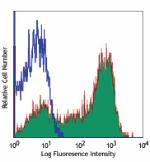
Human peripheral blood lymphocytes stained with DREG-56 APC -
FITC anti-human CD62L
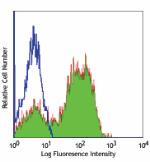
Human peripheral blood lymphocytes stained with DREG-56 FITC -
PE anti-human CD62L
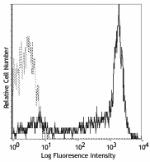
Human peripheral blood lymphocytes stained with DREG-56 PE -
PE/Cyanine5 anti-human CD62L
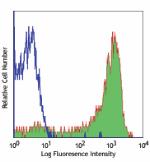
Human peripheral blood lymphocytes stained with DREG-56 PE/C... -
Purified anti-human CD62L

Human peripheral blood lymphocytes stained with purified DRE... -
APC/Cyanine7 anti-human CD62L
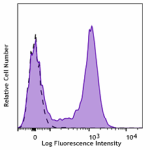
Human peripheral blood lymphocytes were stained with CD62L (... -
Alexa Fluor® 488 anti-human CD62L
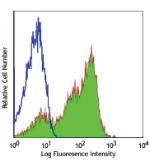
Human peripheral blood lymphocytes stained with DREG-56 Alex... -
Alexa Fluor® 647 anti-human CD62L
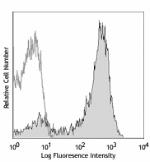
Human peripheral blood lymphocytes stained with DREG56 Alexa... -
Alexa Fluor® 700 anti-human CD62L
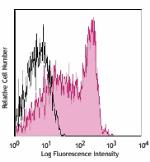
Human peripheral blood lymphocytes stained with DREG-56 Alex... -
PE/Cyanine7 anti-human CD62L
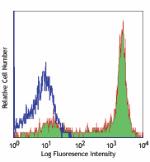
Human peripheral blood lymphocytes stained with DREG-56 PE/C... -
PerCP/Cyanine5.5 anti-human CD62L

Human peripheral blood lymphocytes were stained with CD62L (... -
Pacific Blue™ anti-human CD62L
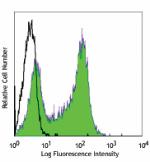
Human peripheral blood lymphocytes stained with DREG-56 Paci... -
Brilliant Violet 421™ anti-human CD62L
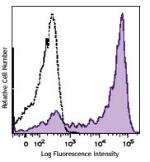
Human peripheral blood lymphocytes were stained with CD62L (... -
Brilliant Violet 785™ anti-human CD62L
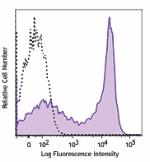
Human peripheral blood lymphocytes were stained with CD62L (... -
Brilliant Violet 650™ anti-human CD62L
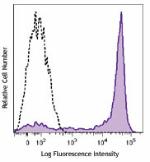
Human peripheral blood lymphocytes were stained with CD62L (... -
PE/Dazzle™ 594 anti-human CD62L
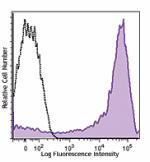
Human peripheral blood lymphocytes were stained with CD62L (... -
Brilliant Violet 605™ anti-human CD62L
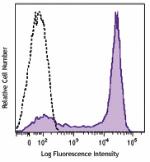
Human peripheral blood lymphocytes were stained with CD62L (... -
Purified anti-human CD62L (Maxpar® Ready)
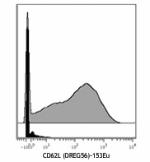
Human Jurkat T cells (top) and human NALM-6 pre-B cells (bot... -
APC/Fire™ 750 anti-human CD62L
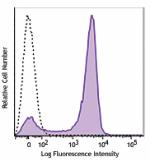
Human peripheral blood lymphocytes were stained with CD62L (... -
Brilliant Violet 510™ anti-human CD62L

Human peripheral blood lymphocytes were stained with CD62L (... -
TotalSeq™-A0147 anti-human CD62L
-
TotalSeq™-B0147 anti-human CD62L
-
TotalSeq™-C0147 anti-human CD62L
-
Ultra-LEAF™ Purified anti-human CD62L

Human peripheral blood lymphocytes stained with Ultra-LEAF™ ... -
Brilliant Violet 711™ anti-human CD62L

Human peripheral blood lymphocytes were stained with CD62L (... -
Spark NIR™ 685 anti-human CD62L

Human peripheral blood lymphocytes were stained with CD62L (... -
TotalSeq™-D0147 anti-human CD62L
-
APC/Fire™ 810 anti-human CD62L

Human peripheral lymphocytes were stained with anti-human 62... -
FITC anti-human CD62L

Typical results from Human peripheral blood lymphocytes stai... -
PE/Dazzle™ 594 anti-human CD62L

Typical results from human peripheral blood lymphocytes stai... -
PerCP/Fire™ 806 anti-human CD62L

Human peripheral blood lymphocytes were stained with anti-hu... -
APC anti-human CD62L

Typical result from human peripheral lymphocytes stained eit... -
GMP FITC anti-human CD62L

Typical results from Human peripheral blood lymphocytes stai... -
Biotin anti-human CD62L

Human peripheral blood mononuclear cells were stained with a... -
Pacific Blue™ anti-human CD62L

Typical results from human peripheral blood lymphocytes stai... -
Spark Blue™ 574 anti-human CD62L (Flexi-Fluor™)
-
PE anti-human CD62L

Typical results from human peripheral blood lymphocytes stai... -
Spark PLUS B550™ anti-human CD62L Antibody

Human peripheral blood lymphocytes were stained with anti-hu... -
GMP PE/Dazzle™ 594 anti-human CD62L

Typical results from human peripheral blood lymphocytes stai... -
StarBright UltraViolet 740 anti-human CD62L

Human peripheral blood lymphocytes were stained with anti-hu...
 Login / Register
Login / Register 

















Follow Us